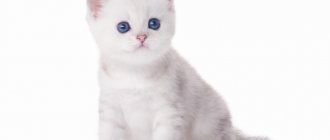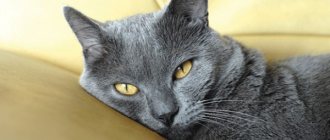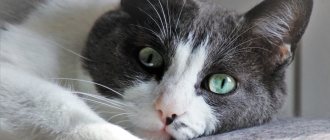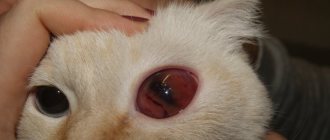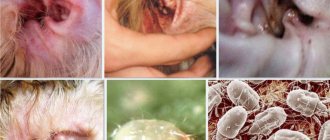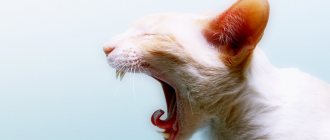For cats, just like for humans, keeping their teeth healthy is very important. Snow-white fangs are not only a sign of beauty, but also the health of the pet in general. If owners are not engaged in professional cat breeding and do not participate in exhibitions, then most often they do not pay attention to the condition of their pet’s teeth. It often doesn’t occur to anyone that a cat’s oral cavity needs careful hygiene. Periodontal disease often occurs in cats due to the owner's negligence. This is inflammation caused by accumulated bacteria.
Symptoms
External signs of periodontal disease in a cat are noticeable at all stages of its development. Depending on the severity of the disease, doctors distinguish the following symptoms:
- Fetid odor from your pet's mouth.
- Bleeding gums even with slight pressure on them. Purulent discharge is possible.
- Redness and swelling of the oral mucosa, as well as excessive salivation.
- Decreased appetite, refusal of solid food. Some cats and cats become emaciated.
- If a cat has periodontal disease, then its teeth often begin to loosen.
- After eating, your jaw may tremble.
- Brown plaque on the crown of the tooth or on the entire surface.
Important! Some symptoms of the disease are characteristic of gingivitis and stomatitis. In order not to start the disease, if you notice the first signs, you should consult a doctor as soon as possible. This will reduce the risk of complications and speed up the healing process. Diagnosis of periodontal disease is made using a visual examination of the oral cavity, x-ray examination, and also prescribe a general or biochemical blood and urine test.
© shutterstock
Treatment of pathology
If periodontitis in cats was identified at the first stage, then the development of the disease can be stopped with the help of ultrasonic teeth cleaning. After such a procedure, the owner must smear and wipe the tooth enamel at home with a soda solution for another month to prevent a relapse. At the second stage, antibiotics are prescribed - “Sinulox”, “Stomargil”, “Metrogil Denta”. It is advisable to treat wounds with an antiseptic. Sanitation can be carried out with a solution such as Chlorhexidine. Painkillers (Loxicom) are prescribed to treat the symptoms of the disorder. Often, complete removal of the tooth or its root is required. After this, the remaining healthy teeth are thoroughly polished and disinfected. Treatment at home without consulting a doctor is impossible.
Prevention
A number of preventative measures will minimize the risk of periodontal disease in cats and dogs. Experts advise adhering to the following recommendations:
- Regular oral hygiene. There are special toothpastes for cats that have an anti-inflammatory effect and eliminate plaque. It is recommended to massage your gums while brushing your teeth.
- Avoid traumatic toys; it is best to use rubber or any other toys, but not metal ones.
- A varied, balanced diet and the inclusion of special professional food for cats in the diet.
- Regular examinations by a veterinarian to rule out periodontal disease. And also for removing tartar.
- If teeth are lost, restore them in a timely manner.
If you consult a specialist in a timely manner and if medications are prescribed correctly, the likelihood of complications is extremely low. In case of advanced periodontal disease, treatment can take a long time. In addition, there is a high risk of complications as a result of which the cat may be left without teeth. Remember, the sooner you seek help from a veterinarian, the faster he will rid your cat of the disease.
Characteristic signs of periodontal disease in cats and methods of treatment
Representatives of the cat family are extremely reluctant to allow the owner to examine their teeth and gums. In addition, the owners themselves often do not pay due attention to the oral hygiene of their furry pet. That is why they often come to the veterinarian with already progressing ailments of the oral cavity. One of them is periodontal disease in cats. The article will discuss in detail the stages and causes of this disease, listing characteristic symptoms and treatment methods.
A little anatomy
In total, a cat has 30 permanent teeth, which replace milk teeth. There are 26 temporary ones and they are replaced at the age of 5 to 7 months. Around the root of the tooth there is a special complex - the periodontium, which ensures the fixation of the crown in the jaw.
The periodontium includes the gingival socket, the periodontal ligament and the bone part of the alveolar processes and the cementum of the tooth. With periodontal disease, it is these elements that are affected, which later leads to tooth loss.
Plaque on teeth is a colony of bacteria, which provokes the onset of inflammation in the gums during periodontal disease. Nature intended that the gingival margin independently regenerates, maintaining the integrity of the periodontal complex. When the restoration balance is disturbed due to the pathological influence of microorganisms, the gum edge decreases and the tooth ends are exposed. Then the process moves to the bone part and leads to destruction and loss of teeth.
The main reason for the development of inflammatory processes in the periodontium is poor oral hygiene and the formation of plaque and tartar. In addition, there are other causes and predisposing factors:
- Inflammatory processes of the gums and mucous membranes - stomatitis, gingivitis. In this case, periodontal disease is a complication of these diseases.
- Traumatization of the mucous membrane.
- Lack of vitamins and minerals.
- Diseases of the gastrointestinal tract.
Causes
The cause of the disease is pathogenic microorganisms and organic substances, which, when attached to each other, form dental plaque. Bacteria that multiply in the gingival folds produce toxins that increase the inflammatory process, causing redness, swelling, and loosening of the gums.
By exerting a constant impact on the gum edge, bacteria prevent the regeneration of damaged tissue. After penetration into the bone area, the teeth begin to decay.
Persian cats are especially susceptible to this disease. This is due to the structure of their oral cavity - after eating, food debris lingers on the teeth, as a result of which, over time, tartar forms on their surface.
Other causes of the disease include:
- Injuries to the mucous membranes of the oral cavity. Injury to the gums can occur during animal fights or during careless eating of fish or poultry bones. As a result, infection gets into the wounds, and the inflammatory process spreads to the teeth.
- Gastrointestinal diseases in which the infection spreads into the oral cavity.
- Vitamin deficiency, unbalanced diet. Pets that live at home are not able to independently obtain food that is healthy for their health. Therefore, they may suffer from vitamin deficiency. To prevent its development, owners of indoor cats need to provide them with a sufficient amount of nutrients. It is recommended that pets be periodically given vitamin complexes for cats.
- The presence of gingivitis or stomatitis. These diseases often cause periodontal disease. Therefore, it is necessary to check the condition of the cat’s oral cavity at least once a month. And if suspicious symptoms occur, immediately visit the veterinarian.
- Renal failure, diabetes mellitus, rhinotracheitis, immunodeficiency. The listed pathologies can also lead to the development of periodontal disease, so it is necessary to constantly monitor the condition of the teeth of animals suffering from such diseases.
If yellow plaque and tartar are found on the teeth, hygiene procedures should be carried out daily, using toothbrushes and toothpastes for cats.
Stages of periodontal disease
Age has no effect on the occurrence of the disease. The most accurate way to make a correct diagnosis is an x-ray of the skull, but in which you can consider 4 stages of the disease:
- There are no changes in the X-ray picture, only external signs are detected - redness, swelling of the gums, the presence of tartar and putrid odor from the mouth.
- Already in the picture, a deficiency of bone mass of about a quarter of the total volume is noticeable.
- Serious destructive changes are visible in the dental alveoli; bone mass deficiency is already more than half.
- At the last stage, purulent processes begin - abscess cavities are visible on x-rays, the bone part of the alveolar processes is destroyed.
Periodontal disease begins abruptly as an independent disease, in most cases it is a complication of gum disease. Therefore, new symptoms are added to the symptoms of redness, swelling and odor from the mouth. The owner may notice a preference for soft food or a complete refusal to eat due to pain. While eating, characteristic “chomping” sounds are heard, and spontaneous bleeding occurs when pressing or biting.
All these symptoms are accompanied by severe pain, the animal becomes angry and aggressive. As the disease progresses, the teeth begin to loosen; they seem to crawl out of their sockets, exposing the roots. Already at the second stage, tooth loss occurs due to destruction of the gingival margin and periodontal disorders.
At the last stage, purulent lesions of the gum sockets and abscess formation occur, and an increasing number of teeth are involved in the process.
At this stage, home treatment is strictly prohibited. All abscess cavities are located deep in the gum tissue, they can affect the jaw bones and even lead to sepsis of the animal, which quickly ends in death in the pet.
Signs
Features indicating dental problems in cats:
- Bad breath. One of the main reasons for visiting a veterinarian. The smell from the mouth becomes unbearable, putrid in nature, and can be felt from afar (when the animal enters the room).
- Decreased appetite. The cat wants to eat, but cannot. Refuses the once-favorite “crackers”, preferring soft food.
- Strange behavior. Owners notice how the pet shakes its head, rubs its muzzle with its paw, as if trying to get something out of its mouth. Sometimes you can clearly hear teeth grinding. The cat slurps when chewing. After eating, the lower jaw may tremble.
- Constant discharge from the mouth. A sick animal will drool profusely. Blood or pus may occasionally leak from the mouth. The fur on the chin is wet all the time, the skin becomes inflamed.
- Tartar and gum inflammation. If the cat is calm, you can move the upper lip and look into the mouth without opening its mouth. It is easy to notice yellow-brown tartar - massive hard deposits that sometimes completely cover the tooth itself. The gums are bright red or bluish in color and bleed. When pressed, a pus-like gray mass may come out from under it.
Diagnostics
First of all, the veterinarian will pay attention to a complete examination of the oral cavity. The degree of damage and inflammation of the mucous membranes is assessed. With periodontal disease, you can observe swelling and red color of the gums, and bleeding in the acute period. Sometimes the opposite clinical picture is observed - the gums are pale, the gingival margin is atrophied, and the roots of the teeth are visible.
When diagnosing, it is worth taking into account the age of the cat; changes in the gums and teeth can occur due to senile degenerative changes in the alveolar processes and gum pockets.
To accurately determine the disease, an X-ray examination of the jaws should be performed. To evaluate the resulting picture correctly, good quality images in several projections are needed, so X-rays are often performed under sedation.
The images clearly show lysis and degenerative changes in the tissues of the jaw, abscess cavities and damage to the periosteum and jaw bones.
It is also recommended to conduct a number of standard tests - general and biochemical blood and urine tests.
Depending on the severity of the disease, therapy is divided into 2 types - conservative and surgical.
Conservative is used in the initial stages of periodontal disease development. It consists of hygienic cleaning of teeth from plaque and tartar. After this procedure, the crowns are coated with a fluoride-containing protective varnish. I treat the gums with antiseptic solutions and dental ointments (for example, Metrogil Denta).
During surgical intervention, the main goal is to eliminate atrophy of the gingival margin and resorption of bone tissue. All efforts are aimed at strengthening the tooth in the hole and closing its defect.
The patch method is one of the most common treatment methods. During it, an incision is made on the upper part of the gum, this flap is lifted, and the tooth root underneath is cleaned. Then the gum is returned to its place and sutured.
If the process has affected a large number of teeth, then splinting is performed to eliminate looseness; sometimes the splints can be replaced with dentures. If there are decayed teeth, they are removed.
Antibiotic therapy is indicated for surgery and abscess formation. The purulent cavities are opened and drainage is installed.
- Regular examination by a veterinary dentist and daily hygienic oral care.
- Inclusion of preventative food for cleaning and preventing tartar. To cleanse plaque from teeth, you can buy dried tendons for your pet.
- Nutrition should be rational and balanced, and in no case should it include only soft types of food.
- Toys should not be metal.
- If teeth are lost or removed, install dentures in a timely manner to prevent dentition disorders and excessive load on the remaining teeth.
Periodontal disease and periodontitis: what is the difference?
Very often one of the names of diseases circulates among pet owners. However, periodontal disease and periodontitis are fundamentally two different nosological units.
It is important for veterinarians to know this in order to make a correct diagnosis of cats, prescribe the correct therapy and further prevention.
Distinctive features of periodontal disease and periodontitis:
- Periodontitis is an acute inflammatory disease of the gums, leading to periodontal destruction, the course of which most often does not exceed 30 days, while periodontal disease is a chronic phenomenon, developing extremely slowly, possibly with an intermediate pathological condition (gingivitis).
- The main process in periodontitis is inflammation, while, as in periodontal disease, it is degeneration and destruction of bone tissue.
- With periodontitis, without the necessary therapy, teeth fall out within 60-90 days. With periodontal disease, teeth can be preserved for several years.
Reference!
There are situations when periodontal disease is accompanied by a secondary infection and the appearance of an inflammatory process on the gums. This may somewhat complicate the differential diagnosis of pathological processes.
Stages of disease development and their symptoms
Like many diseases in veterinary medicine, periodontal disease has a gradual development of clinical manifestations. There are 4 stages in total:
- Stage 1 – the presence of only clinical manifestations. The X-ray picture of the jaw and teeth is within normal limits. In this case, the cat exhibits clinical manifestations. The gums show severe swelling and redness. When examining the teeth, tartar is detected (accumulated plaque from a long absence or improper sanitization of the cat’s mouth). Due to the active proliferation of bacterial flora, an extremely unpleasant or even putrid odor will emanate from the pet’s mouth.
Reference!
According to modern ideas of veterinarians, at the first stage of the development of periodontal disease, a diagnosis of “gingivitis” should be made, since it is impossible to differentiate these 2 conditions based on clinical manifestations.
- Stage 2 – the appearance of changes in the x-ray of the cat’s jaw. It becomes clearly visible that the amount of bone tissue has decreased by ¼ part (25%) of the required amount.
- Stage 3. Dystrophy reaches the periodontium. The volume of bone tissue is already reduced by ½ of normal. The clinical picture is also accompanied by severe bleeding of the gums, which can be easily provoked even by a light touch to the pathological gum.
- Stage 4. All pathological processes are accompanied by a purulent secondary infection. Purulent foci appear not only on the gums themselves, but throughout the animal’s entire oral cavity. The alveolar processes of teeth are subject to severe destruction. The cat's teeth are very loose and can fall out spontaneously.
Important!
Since cats are extremely patient animals, in the first stages of the development of the disease, it is very rare for owners to bring the animal to the clinic. However, in the final stages, the disease is much more difficult to treat and is much more painful for the cat to tolerate. It follows from this that you need to take care of your pet’s oral cavity.
How dangerous is the disease?
Even though this is a gum disease, the consequences for cats can be dire. For example:
- Periodontal disease in cats leads to tooth loss. Not only is this not aesthetically pleasing (after all, a cat with beautiful teeth in full is more beautiful, isn’t it?), it also makes the cat’s life much more difficult, since it becomes impossible for him to chew food.
Reference! With the development of periodontal disease, even if they have teeth, cats do not chew food, but try to swallow it whole. This is due to severe pain in the cat, which he tries to avoid in this way.
- With periodontal disease, active reproduction of various pathogenic microorganisms occurs in the oral cavity, the waste products of which are toxic to the cat’s body. This affects the general condition of the fluffy’s body.
- If the cat is old, pregnant, or has a weakened immune system for any other reason, periodontitis can lead to such a serious complication as sepsis, which can lead to the death of the animal.
Reference!
Sepsis is a severe generalized condition of the body that occurs when an infectious agent enters the blood of an animal. The literal translation from Latin is putrid blood.
It is within the power of the owners to prevent the development of complications. To do this, it is enough to take the cat to a veterinary doctor on time and strictly follow his recommendations, even if this will not be very pleasant for the pet.
What is periodontal disease?
Periodontal disease involves several infectious conditions that cause progressive inflammation in the skeletal and muscular structures that support the teeth. Currently, it is estimated that about 80% of the world's cat population suffers from periodontitis to some degree. This disease is the leading cause of tooth loss in adult cats and can severely threaten their teeth.
Why does periodontal disease occur?
The most important reason for the occurrence of periodontal disease is the lack of proper care for the cat’s oral cavity.
Among the abundance of the latest developments in dentistry (specialized toothbrushes and pastes for cats, developed by veterinarian dentists), the presence of many salons providing teeth cleaning services, and recommendation articles on the Internet, owners still neglect the dental health of their charges.
Just like humans, cats have food particles left on their teeth, which gradually leads to the formation of plaque on their teeth. The cat's teeth turn yellow. If this sign is further ignored, food debris accumulates more and more on the teeth and gums, which leads to the formation of tartar - a hard plaque located at the junction of the tooth and gum.
This stone is a good nutrient medium for oral microflora. Bacteria actively multiply, which initially leads to gingivitis and then to periodontal disease.
However, insufficient hygiene of the cat’s mouth is not the only reason for the appearance of pathology. Periodontal disease also develops due to:
- Injuries to the mucous membranes in the oral cavity. The most trivial situations of trauma (a fight with another animal, a scratch from fish bones, etc.) can lead to periodontal disease.
- Vitamin deficiency and deficiency of micro- and macroelements. Very often, a domestic cat cannot independently maintain the mineral and vitamin balance in its body, so this responsibility is entirely transferred to the shoulders of the owner.
- Periodontal disease can often appear as a result of any malfunction of the pet’s gastrointestinal tract.
- Inflammatory diseases of the oral cavity (gingivitis, stomatitis) serve as the beginning of periodontal disease.
Attention!
If the slightest deviation in the diet or appearance of the cat’s gums and teeth appears, you should immediately show it to a veterinarian!
How to detect periodontal disease?
No matter how paradoxical it may be, even the owner of the animal can carry out the initial diagnosis. To do this, you just need to pay attention to the cat’s behavior (how he eats, whether he chews food, whether he scratches his teeth with his paw, etc.) and examine his mouth.
In this case, clinical signs are revealed: redness of the gums, tartar, and so on. If this clinical picture is detected, the owner is obliged (if the cat’s health is dear to him) to take him to a veterinary clinic as soon as possible.
There, doctors conduct a full examination of the oral cavity and determine the location and area of the lesion. For a more accurate diagnosis of the stage of the disease, X-ray instrumental diagnostic measures are performed. Photographs of the jaw and teeth will give the doctor grounds to make a diagnosis of “periodontal disease” and at what stage the disease is developing.
The cat is also prescribed a general blood and urine test to determine the degree of generalization of the infection (leukocytosis, changes in the leukocyte formula to an inflammatory pattern, erythrocyte sedimentation rate (ESR), leukocyturia and other changes).
Therapy at different stages of the disease differs significantly.
In mild (1 and 2) stages, when the periodontium is not yet affected by the pathological process, doctors most often make do with conservative treatment. Its main stages:
- Teeth cleaning. A veterinary doctor removes tartar and plaque from the enamel using surgical instruments or ultrasound.
- Teeth polishing (optional). The owner may be asked to polish the cat's tooth enamel. This is done in order to prevent the proliferation of bacteria (on the smooth polished surface of the teeth there is no place for microorganisms to attach, so they do not have the opportunity to reproduce).
- Coating of teeth with a special varnish containing fluoride. This event is carried out to strengthen the cat’s teeth.
- The gums are treated with an antiseptic to destroy pathological bacteria.
- To relieve inflammation, the doctor may prescribe antibacterial drugs (metronidazole, ABs of the cephalosporin group and others) and veterinary drops for lubricating the gums (“Zubastic”).
There are situations when even in the early stages there is a need to resort to surgical intervention, but this happens extremely rarely in some special cases.
Important!
You should not remove tartar yourself, as you can damage your gums and teeth, as well as the mucous membranes of your mouth. At the veterinary clinic, specialists will do everything carefully, in sterile conditions and, if necessary, put the animal under anesthesia to make it easier for him to endure the procedure.
Unfortunately, advanced cases (stages 3 and 4) have to be treated surgically. Veterinary dentists perform the following operations:
- Removing gum atrophy and strengthening teeth in sockets. It is important to completely clean the roots of the affected teeth.
- If preservation is impossible, the teeth are removed.
IMPORTANT. After surgery, you should definitely take antibacterial drugs prescribed by your doctor!
How to prevent a cat from developing pathology?
- You should monitor your cat's oral cavity. You need to purchase a toothbrush and toothpaste for your cat from a veterinary pharmacy and brush his teeth regularly. Yes, he may not like it (even, most likely, this is exactly what will happen), but he will clearly like injecting antibiotics and recovering from anesthesia less.
- It is important to monitor your pet's diet. If you feed dry food, it should be premium food, as it contains substances that help prevent the formation of tartar. At the same time, cheap food, on the contrary, contains many substances that contribute to the formation of stones not only on the teeth, but also in other organs (kidneys, gall bladder). Also, premium food contains a sufficiently balanced amount of nutrients, vitamins and minerals, which has a beneficial effect on the cat’s overall health.
Attention!
Premium food must be purchased only in specialized veterinary pharmacies!
- Treat injuries and inflammatory diseases of the oral cavity in a timely manner.
Periodontal disease is a terrible disease that leads to disruption of the life and well-being of a pet. However, this is quite easy to avoid. Simply paying enough attention to a purring family member is enough. Then your cat will make you happy every day, because a healthy cat is a happy cat!
Useful materials:
- Tobrex for cats Instructions for useTobrex drops contain a broad-spectrum antibiotic - tobramycin from the group...
- Amlodipine for cats Instructions for use of Amlodipine: in medicine and veterinary medicine VetConsultPlus Information portal Therapy Brief characteristics…
- Cutaneous horn General description of the disease Cutaneous horn on the forehead or face (ICD 10 code - L57.0) -...
- Fosprenil for cats Instructions for use Fosprenil is administered to a cat intravenously, intramuscularly or subcutaneously. If necessary, an injection is allowed in…
Reasons for development
The main reason, according to veterinarians, is considered to be episodic or completely absent oral hygiene in cats. However, there are a number of factors that can accelerate the manifestation of pathology. These include:
- Diseases of inflammatory etiology located in the pet’s mouth (for example, stomatitis). In this case, periodontal disease acts as a “background” disease that aggravates the course of the main disease.
- Wounds and damage to the oral mucosa.
- A meager diet, not enriched with vitamins and microelements important for the body.
- Pathological processes occurring in the cat's gastrointestinal tract.

